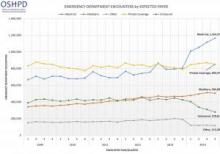Medi-Cal Expansion, ER Usage Linked

When a patient shows up at a California emergency room, the likelihood that they are enrolled in the Medi-Cal program has skyrocketed, new state data shows.
According to the information from the Office of Statewide Health Planning and Development, ER visitors who identified as Medi-Cal patients rose some 50% from 2013 to last year, from just under 800,000 in the first quarter of 2013 to 1.16 million during the fourth quarter of 2014.
Industry observers say the rise appears to dovetail with the enrollment of millions more Californians into the Medi-Cal program as a result of the expansion of the Affordable Care Act.
The number of patients who identified as uninsured seeking care at the ER also dropped significantly, from about 450,000 in the third quarter of 2013 to 278,000 in the fourth quarter of 2014.
Those ER patients classified as “other” also dropped from about 200,000 in the fourth quarter of 2013 to 115,494
California is one of 30 states that has expanded eligibility for Medicaid coverage under the Affordable Care Act, with income cutoffs raised from below the federal poverty level to 138%, or just under $33,000 for a family of four. Childless adults also became eligible for coverage.
The federal government is paying for the cost of the expansion for the first three years, and 90% in the years after that indefinitely. The expansion has been a remarkable success in the Golden State. Medi-Cal enrollment grew by by nearly a third, from 8.6 million in the fall of 2013 to 11.3 million as of late last year. It has also proven a boon for Medi-Cal managed care plans. Inland Empire Health Plan, for example, saw its enrollment double from 500,000 in 2011 to currently more than 1 million lives. That included 350,000 new enrollees added in 2014.
“There is a direct correlation with the expansion of Medi-Cal in 2013 and early 2014, and this is what you would expect,” said Anthony Wright, executive director of Health Access, a Sacramento-based advocacy organization. Wright is a member of the Payers & Providers editorial board.
“It appears that there is nearly a one-to-one correlation between the drop in uninsured ER visits and the increase in Medi-Cal enrollees seeking care in the ER. We believe that this may well be attributed to the ACA,” said Jan Emerson-Shea, vice president of external relations for the California Hospital Association, said in an email.
Wright noted that many uninsured may be enrolled when visiting the ER, particularly if the hospital is participating in the state’s Medi-Cal presumptive eligibility program. “Even if they come in as uninsured, they get booked as Medi-Cal,” he said.
Emerson-Shea noted that the emergency room visits spiked among Medi-Cal enrollees may be connected to the relatively paltry reimbursements the program pays doctors -- one of the lowest in the nation.
“Even though more people are now on the Medi-Cal rolls, they don’t necessarily have access to a physician...we believe that many of these people are still seeking care in the ER,” she said.






